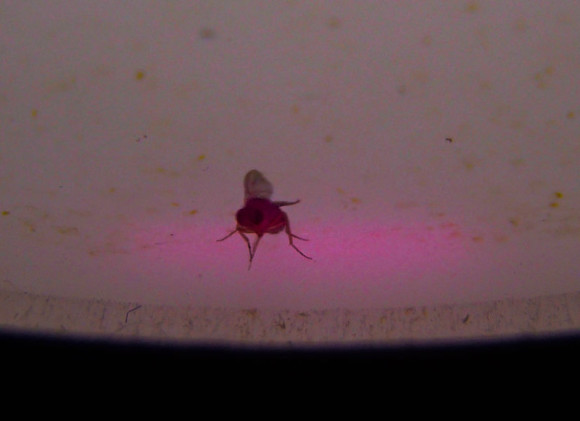
A team of scientists have developed a special device to control the neurons (brain cells) of flies. This tool, called FlyMAD, enabled the scientists to target light or heat to specific body regions of flies in motion and to analyze the animals’ brain cells.
The fruit fly Drosophila Melanogaster represents an ideal experimental system to analyze circuit functions of neurons, though in the past, it was not possible to specifically control the activity of neurons in moving flies.
Rapid mind alteration in moving flies
An international team of scientists let by Andrew Straw of the Institute of Molecular Pathology were interested in the mechanisms underlying cell circuits in the fly brain. In order to better understand how different neuronal circuits work together, Straw and his team developed FlyMAD (“Fly Mind Altering Device”), an apparatus using a video camera to track the flies’ motion in a box. FlyMAD allows simultaneous observation of several flies and targeted irradiation of specific body regions of these animals.
The novel technology uses genetically modified, temperature-sensitive flies. Upon irradiation with infrared light and the a rise in temperature to 30 degrees Celsius, these animals change certain aspects of their behavior within the fraction of a second.
Straw and his co-workers tested FlyMAD by analyzing already known reactions of genetically modified flies to light and heat. As this proof-of-principle showed that FlyMAD worked reliably – for example by making the flies “moonwalk” – the researchers went on to use their method to tackle new scientific questions. In a thermogenetic set up, they investigated a certain type of neurons that had been linked to the flies’ courtship song in earlier experiments. Taking advantage of the better temporal resolution of FlyMAD, the scientists were able to characterize the role of two neuronal cell types in the brain in more detail. They could show that activity of one type of neurons correlated with a persistent state of courtship, whereas the other cell type was important for the action of “singing.” In the experiment this became obvious when males tried to mate with a ball of wax, circled it and started vibrating their wings after stimulation with the laser beam.
Read more from the Research Institute of Molecular Pathology











